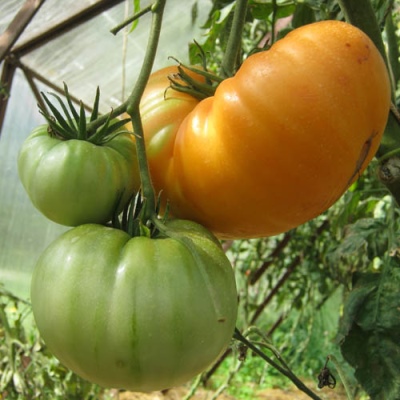
- Name synonyms: Hawaiian Pineapple
- Category: grade
- Growth type: indeterminate
- Appointment: fresh consumption, for juice
- Ripening period: mid-season
- Ripening time, days: 105
- Growing conditions: for film greenhouses
- Bush size: tall
- Bush height, cm: 180-200
- Leaves: ordinary
Yellow tomatoes are a rarity in the garden plots of summer residents. The Hawaiian pineapple tomato, the work of Canadian breeders, received this name for a reason. The variety has not only large orange fruits, but also an unusual pronounced pineapple flavor.
Description of the variety
It belongs to indeterminate varieties, that is, it does not have an end point of growth. The height of the bushes is 180-200 cm, they should be tied up, dived and shaped. Leaves of normal length, green. 5-6 fruits are formed on each cluster.
Mostly Hawaiian pineapple is grown in greenhouses, but it can also be grown on the ground, depending on the climatic conditions of the region. Grows best in central Russia.
The main qualities of the fruit
Large-fruited variety. The weight of one tomato varies from 300 to 700 g. A remarkable feature of the tomato is the complete absence of seeds in the juicy and dense pulp. Ripe fruits have a rich orange color, with pink stains on the bottom. Their shape is flat-round.
They are not grown on an industrial scale because of the poor keeping quality and transportability of the harvested crop. Once harvested, ripe fruits must be processed within a few days.
Taste characteristics
Tomato has an unusual pleasant sweet taste, with slightly noticeable fruity notes in the aftertaste. The more ripe the fruits are, the more intense and aromatic they taste.
Excellent taste allows their use in baby and diet food due to their hypoallergenic properties. They can be consumed both fresh and processed. Mostly juices are prepared, they are not suitable for canning, since the fruits are quite large.
Ripening and fruiting
The technical ripeness of tomatoes occurs 105 days after planting. The variety is mid-season. The duration of fruiting is high, the harvest is harvested from mid-July to September. If the weather is dry and warm, you can harvest until October.
Yield
From one bush, you can collect 15-20 kg of fragrant tasty fruits.
The timing of planting seedlings and planting in the ground
Seeds begin to germinate 55-60 days before planting in a permanent place, in March - early April. They can be grown in a greenhouse, under a layer of film, or in separate cups. The soil should be chosen fertile, moisture permeable.
Before planting, the seeds must be disinfected in a weak solution of potassium permanganate and stimulated for better germination in a special preparation.
The soil is well moistened with warm water. Shallow grooves of 1 cm are made, carefully submerging them, and sprinkled with earth without ramming it. After planting, the ground is again watered with warm water and placed in a well-lit and heated room.
Hawaiian pineapple, like all yellow tomatoes, has poor root recovery after transplantation. Therefore, for the successful development of seedlings, it is best to use peat cups. This will make the plant less stressed.
Seeds begin to germinate at a temperature of 25-27 degrees, after germination it is lowered to a level of 17-20. The soil is moistened as it dries. After 2 full leaves appear on the seedlings, they dive.
Since the plant is tall, for better development you need to make additional fertilizing: fluorine, nitrogen and potassium.
Landing in a permanent place begins in May, when the weather is warm outside. At the end of April, seedlings are planted in greenhouses.

Growing tomato seedlings is an extremely important process, because it largely depends on whether the gardener will be able to harvest at all. All aspects must be taken into account, from seedbed preparation to planting in the ground.
Landing scheme
When planting, the tallness of the culture should be taken into account. The distance between the holes is 50-60 cm, between the tomatoes - 40-60 cm. No more than 2-3 plants can be planted on one square meter.

Growing and care
Tomato Hawaiian pineapple is a rather capricious crop and requires maintenance. He loves warmth and fresh air, but does not tolerate excessive heat and drafts. Watering must be controlled. The soil must not be overmoistened and overdried. In this case, drip irrigation and soil mulching are appropriate.
The landing site should be well-lit and well-ventilated. The bushes should be well blown so that moisture does not accumulate between them. This will protect the culture from many fungal diseases. And also it is not necessary to plant in areas where bell peppers and potatoes previously grew.
Be sure to install trellis supports, to which the shoots will be tied. Even if fertile soil is used, additional nutrition allows the plant to develop better, not get sick and give large and tasty fruits. It can be both mineral and organic fertilizers.
Among garden activities, weeds are also removed, weeding beds.
Disease and pest resistance
According to the reviews of experienced gardeners, the plant is quite resistant to many infectious diseases. However, for preventive purposes, to protect against late blight and the whitefly pest during the flowering period, the bushes should be treated with special preparations.




A plant needs different micronutrients at each stage of growth. All fertilizers can be divided into two groups: mineral and organic. Folk remedies are often used: iodine, yeast, bird droppings, eggshells.
It is important to observe the rate and period of feeding. This also applies to folk remedies and organic fertilizers.



























































































